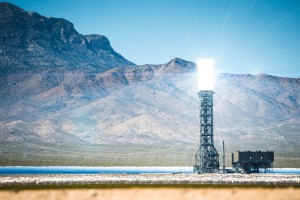
Today solar and wind power becomes more and more commonplace, but there is still a basic problem that comes with these solutions, how do you store the energy produced to be used at a later time? Scientists at GE Global Research have decided to try and solve this problem by storing some of the heat generated by thermal solar power plants in carbon dioxide.
These power plants concentrate solar rays with vast fields of mirrors and use the heat to generate steam that spins a turbine. The carbon dioxide stored under ground is cooled to a solid dry ice state using excess grid power, and when extra electricity is needed, for instance during night, the heated salt then can be used to warm up the solid CO2 to a “supercritical” state between a gas and solid.
Even if battery technology has improved in later years, it is still not a viable solution at a larger scale, for instance for a whole community, as it comes at a high cost. Both in financial cost and the cost to the environment as most batteries still relies on materials mined in questionable ways. The problem with storing energy also prevents solar power from becoming the only source of energy in a larger scale, and dependency on more traditional, less ideal energy sources, is still needed. Similar problems arise with wind power. Sometimes there is not enough wind, and sometimes actually to much so windmills needs to be stopped to prevent a catastrophic failure.
“That’s the grand challenge,” says Stephen Sanborn, senior engineer and principal investigator at GE Global Research (GRC). “We need to make renewable energy available to the grid when it is needed.”
Sanborn and his team decided to solve this problem by storing some of the heat generated by thermal solar power plants in carbon dioxide. The irony, of course, is that CO2 is considered the prime contributor to climate change, and the reason the world is switching to renewable energy in the first place.
Here’s how it works. The design has two main parts. The first one collects heat energy from the sun and stores it in a liquid of molten salt. “This is the hot side of the solution,” Sanborn says. The other component uses surplus electricity from the grid to cool a pool of liquid CO2 so that it becomes dry ice. During power generation, the salt releases the heat to expand the cold CO2 into a supercritical fluid, a state of matter where it no longer has specific liquid and gas phases. It allows engineers to make the system more efficient.
The supercritical fluid will flow into an innovative CO2 turbine called the sunrotor, which is based on a GE steam turbine design. Although the turbine is so small it can fit on an office shelf, it still can generate as much as 100 megawatts of “fast electricity” per installed unit—enough to power 100,000 U.S. homes.
Sanborn believes that a large-scale deployment of the design would be able to store “significant amounts” of power —— and deliver it back to the grid when needed. “We’re not talking about three car batteries here,” he says. “The result is a high-efficiency, high-performance renewable energy system that will reduce the use of fossil fuels for power generation.”
The process is highly efficient, Sanborn says, yielding as much as 68 percent of the stored energy back to the grid. The most efficient gas power plants yield 61 percent. The team is now building a conceptual design, which Sanborn believes could take five to 10 years to get from concept to market.
The work is part of a research partnership between the GRC and the U.S. Department of Energy. Sanborn says the solution could revolutionize the solar power industry and also make natural-gas power plants more efficient.
